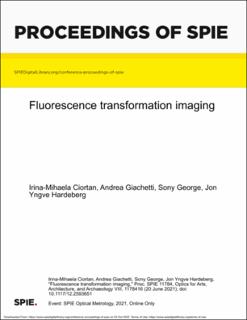| dc.description.abstract | Fluorescence is a photoluminescence phenomenon where light is absorbed at lower wavelengths and re-emitted at longer wavelengths. For classic artworks, fluorescence gives useful information about varnish and retouches. At the same time, modern artworks may employ synthetic fluorescent pigments because of their special appearance properties, such as increased brightness and vividness provoked by self-luminescence. Hence, it is relevant to investigate the fluorescent signals of cultural heritage objects when studying their appearance. This work proposes a variant to Reflectance Transformation Imaging (RTI) technique, namely Fluorescence Transformation Imaging. Reflectance Transformation Imaging method outputs a single-camera multi-light image collection of a static scene, which can be used to model the reflectance of the scene as a polynomial of the illumination directions. Similarly, Fluorescence Transformation Imaging aims to model the fluorescent signal based on a series of images with fixed scene and viewpoint and varying incident light directions - what changes with respect to RTI is that the wavelength of incident light needs to be shorter than the sensing wavelength. In the literature, there are works that explore the isotropic property of fluorescence in low-dimension multi-light imagery methods (such as Photometric Stereo) to model the appearance of an object with a first-order polynomial. This is because in the fluorescent mode the object gets closer to a Lambertian surface than in the reflective mode where non-Lambertian effects such as highlights are more likely to appear. Nonetheless, this assumption stands for single-object scenes, with uniform albedo and convex geometries. When there are multiple fluorescent objects in the scene, with concavities and non-uniform fluorescent component, then the fluorescence can become secondary light to the object and create interreflections. This paper explores the Reflectance and Fluorescence Transformation Imaging methods and the resulting texture maps for appearance rendering of heterogeneous non-flat fluorescent objects. | en_US |
